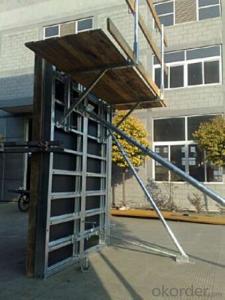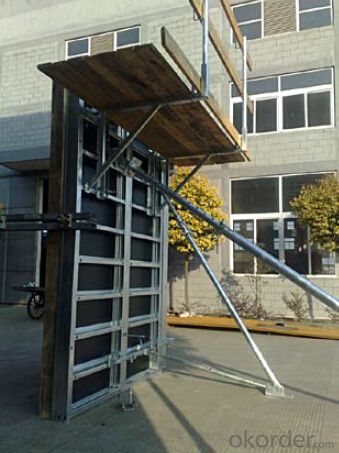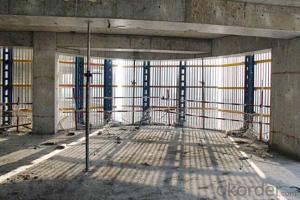Steel-frame formwork platform
- Loading Port:
- China Main Port
- Payment Terms:
- TT OR LC
- Min Order Qty:
- -
- Supply Capability:
- -
OKorder Service Pledge
OKorder Financial Service
You Might Also Like
Steel-frame Formwork SF-140
Characteristics:
◆ Few parts for fast forming.
◆ Max. Concrete pressure: 80KN/m2.
◆ Hot-dip galvanized steel frame.
◆ The thickness of plywood is 18mm & the panel is 14cm.
◆ Compatibility with Hunnebeck Manto system due to similar edge profile.
System Details & Application:
◆ Neat joint and fast assembling with aligning panel clamp.
◆ Flexible panel arrangement and height extension.
◆ The selection of panels.
◆ Kinds of panel connectors.
◆ Corner clamp application.
◆ Length adjustment application.
◆ Height adjustment & aligning strut.
◆ Walkway bracket & platform.




- Q: How does steel formwork affect the overall construction project management?
- The overall management of a construction project can be greatly influenced by the use of steel formwork. The following are several ways in which it can affect project management: 1. Enhanced time efficiency: Steel formwork is renowned for its durability and ability to be reused, resulting in time savings during construction. By properly planning and coordinating, steel formwork can be easily assembled and disassembled, thus facilitating faster progress in construction. This increased time efficiency can lead to improved project scheduling and overall project management. 2. Cost-effectiveness: Despite potentially having a higher initial cost compared to other formwork materials, steel formwork's reusability makes it a cost-effective choice in the long term. Consequently, project managers can allocate their budget more efficiently, reducing unnecessary expenses and ensuring that the project remains within the designated cost limits. 3. Quality control: Steel formwork provides a smooth and uniform finish to concrete structures. This enables project managers to maintain high-quality standards throughout the construction process. By utilizing steel formwork, project managers can ensure that the final product meets the required specifications and standards, thereby minimizing the need for rework and potential delays. 4. Safety and durability: Due to its strength and stability, steel formwork is a safe option for construction projects. Its robustness helps prevent on-site accidents and creates a secure work environment for construction workers. Additionally, the durability of steel formwork ensures its ability to withstand the pressures exerted during the concrete pouring process, reducing the risk of structural failures and subsequent rework. 5. Flexibility and adaptability: Steel formwork offers a high level of flexibility, allowing project managers to adapt to changes and modifications in construction plans. Whether it involves adjusting the formwork design or reusing the same formwork for different parts of the project, the flexibility of steel formwork enables project managers to promptly respond to unforeseen circumstances, thereby minimizing disruptions to the project. In conclusion, steel formwork significantly impacts overall construction project management by enhancing time efficiency, cost-effectiveness, quality control, safety, and flexibility. Its durability and reusability make it an invaluable asset for project managers, enabling them to deliver projects on time, within budget, and to the desired quality standards.
- Q: How is steel formwork transported to the construction site?
- Depending on the distance, quantity, and accessibility of the construction site, steel formwork is transported using different methods. Truck transportation is a common choice for shorter distances and smaller quantities. This involves loading the steel formwork components onto a flatbed or trailer and driving them to the site. For larger quantities or longer distances, rail or sea transportation may be used. Rail transport is efficient for moving large quantities over long distances, especially when the site is far from the manufacturing facility. On the other hand, sea transport is ideal for international projects that require shipping the formwork overseas. The formwork is loaded into shipping containers and transported by cargo ships. Upon arrival at the construction site, cranes or forklifts are used to unload the steel formwork. The components are then stored in a designated area until they are ready for installation. It is crucial to carefully plan and execute the transportation process to prevent any damage to the formwork. Any issues with structural integrity can adversely affect the quality and safety of the final construction project.
- Q: What are the considerations for designing steel formwork systems?
- When designing steel formwork systems, there are several important considerations that need to be taken into account. These considerations include: 1. Load-bearing capacity: Steel formwork systems must be designed to withstand the loads imposed by the concrete during pouring and curing. This includes the weight of the concrete, as well as any additional loads such as equipment or workers. 2. Safety: The safety of workers is of utmost importance when designing steel formwork systems. The system should be designed to provide a stable and secure working platform, with proper guardrails, access points, and fall protection measures. 3. Durability: Steel formwork systems should be designed to withstand the harsh conditions of construction sites, including exposure to weather elements, chemicals, and repeated use. The materials used should be corrosion-resistant and able to maintain their structural integrity over time. 4. Flexibility and adaptability: The design of the steel formwork system should allow for easy assembly, disassembly, and reusability. It should be adaptable to different project requirements and able to accommodate changes in design or construction methods. 5. Cost-effectiveness: The overall cost of the steel formwork system, including its initial investment, maintenance, and lifespan, should be considered. Designing a system that balances cost with performance and durability is essential. 6. Construction schedule: The design of the steel formwork system should take into account the construction schedule and the time required for assembly, concrete pouring, and formwork removal. The system should be designed to minimize downtime and facilitate efficient construction processes. 7. Environmental impact: Consideration should be given to the environmental impact of the steel formwork system, such as the use of sustainable materials, recycling options, and minimizing waste generation. Overall, designing steel formwork systems requires a comprehensive approach that takes into account structural integrity, safety, durability, flexibility, cost-effectiveness, construction schedule, and environmental factors. By considering these considerations, a well-designed steel formwork system can greatly contribute to the success of a construction project.
- Q: How does steel formwork compare to plastic formwork?
- Construction projects commonly utilize two types of formwork systems: steel formwork and plastic formwork. These systems possess distinct advantages and disadvantages, making them suitable for varying applications. Steel formwork is renowned for its durability and strength, enabling it to withstand heavy loads. Consequently, it is ideal for large-scale projects that necessitate repetitive formwork usage. Compared to plastic formwork, steel formwork boasts a lengthier lifespan, rendering it a cost-effective choice in the long term. It can be effortlessly tailored to meet specific project requirements, thereby permitting design flexibility. Moreover, steel formwork yields a smooth concrete surface finish, reducing the need for supplementary finishing work. Conversely, plastic formwork surpasses steel formwork in several aspects. Its lightweight nature facilitates easy handling and transportation, leading to expedited installation and dismantling times, thereby enhancing overall project efficiency. Plastic formwork is also corrosion-resistant and does not necessitate surface treatment or maintenance. Being reusable and recyclable, it embodies an environmentally friendly option. Furthermore, it possesses commendable insulation properties, thereby facilitating energy consumption reduction in buildings. Regarding cost, steel formwork generally incurs higher upfront expenses due to elevated material and manufacturing costs. Nevertheless, the prolonged lifespan and reusability of steel formwork offset the initial expenditure, rendering it a cost-effective decision for projects involving substantial concrete pouring. In conclusion, the selection between steel formwork and plastic formwork hinges upon specific project requisites. Steel formwork proves suitable for large-scale ventures necessitating durability and strength, whereas plastic formwork is more apt for smaller projects mandating swift installation and dismantling. Both alternatives possess their own merits and demerits, necessitating careful consideration of factors such as cost, project timeline, and design flexibility when arriving at a decision.
- Q: Can steel formwork be used for projects with limited formwork stripping time?
- Yes, steel formwork can be used for projects with limited formwork stripping time. Steel formwork is known for its durability and strength, making it suitable for various construction projects. Unlike traditional formwork materials such as wood or plywood, steel formwork can withstand higher pressures and loadings, allowing for faster construction cycles. Steel formwork is often used in high-rise buildings, bridges, and infrastructure projects where time is of the essence. Its rigid structure allows for quick assembly and disassembly, minimizing the time required for formwork stripping. Additionally, steel formwork can be reused multiple times, further reducing construction time and costs. Furthermore, steel formwork offers precise dimensional control, ensuring accurate and consistent results. This is particularly important for projects with limited formwork stripping time, as any errors or inconsistencies in the formwork can lead to delays and additional work. However, it is important to note that steel formwork may require skilled labor and specialized equipment for installation and removal. Therefore, proper planning and coordination are crucial to ensure efficient and safe use of steel formwork for projects with limited formwork stripping time.
- Q: What is the maximum concrete pressure that steel formwork can withstand?
- The maximum concrete pressure that steel formwork can withstand depends on various factors such as the thickness and type of steel used, the design and construction of the formwork, and the quality of the concrete being poured. However, in general, steel formwork can withstand concrete pressures ranging from 50 to 100 kN/m2 (725 to 1450 psi).
- Q: What are the considerations when designing steel formwork for architectural features?
- When designing steel formwork for architectural features, there are several important considerations that need to be taken into account. These considerations include: 1. Structural integrity: The formwork needs to be designed in such a way that it can withstand the loads and pressures imposed during the construction process. This includes considering the weight of the concrete, as well as any additional loads such as wind or seismic forces. 2. Dimensional accuracy: Architectural features often require precise dimensions and shapes. The steel formwork needs to be designed to ensure that the final product meets these requirements. This may involve using adjustable components or incorporating additional supports to maintain the desired shape. 3. Aesthetic appeal: Architectural features are often designed to be visually appealing. The formwork needs to be designed in a way that allows for the desired aesthetic to be achieved. This may involve using special finishes or textures on the formwork surface, or incorporating decorative elements into the design. 4. Ease of assembly and disassembly: Steel formwork should be designed to be easily assembled and disassembled. This allows for efficient construction processes and reduces the time and effort required for formwork installation and removal. 5. Reusability: In some cases, it may be desirable to reuse the steel formwork for multiple projects. Designing the formwork with this in mind can help minimize waste and reduce costs in the long term. This may involve using durable materials and incorporating features that allow for easy disassembly and reassembly. 6. Safety: Safety is a critical consideration in any construction project. The formwork needs to be designed to ensure the safety of workers during the construction process. This may involve incorporating safety features such as handrails, non-slip surfaces, or fall protection systems. Overall, designing steel formwork for architectural features requires careful consideration of structural integrity, dimensional accuracy, aesthetic appeal, ease of assembly, reusability, and safety. By addressing these considerations, a well-designed steel formwork system can facilitate the construction of visually appealing and structurally sound architectural features.
- Q: What are the different types of joints used with steel formwork?
- Steel formwork joints in construction projects can be categorized into different types, each serving a specific purpose. These joints are crucial for ensuring stability, strength, and ease of assembly and disassembly. Here are some commonly used joints: 1. Straight Sections: For connecting straight sections of formwork, a simple butt joint is employed, where the edges of two steel formwork sections are placed together. 2. Longer Sections: To provide additional strength for longer sections of formwork, a lap joint is used. In this joint, one formwork section overlaps another, creating a strong connection. 3. Adjustable and Repositionable: A clamped joint utilizes clamps or bolts to securely fasten the formwork sections together. This joint allows for easy adjustment and repositioning of the formwork. 4. Vertical and Horizontal Connections: A wedge joint is commonly used to connect vertical and horizontal formwork sections. It involves inserting a wedge-shaped piece into a slot to create a secure connection. 5. Large and Heavy Components: A flanged joint is created by using flanges or plates on the formwork sections, which overlap and are bolted together. This joint provides a strong connection and is ideal for large and heavy formwork components. 6. Quick Assembly and Disassembly: For quick and easy assembly and disassembly of formwork sections, a pin joint is utilized. Pins or dowels are used to connect the formwork sections securely. Selecting the appropriate joint type is essential and should be based on the specific requirements of the construction project. Factors such as formwork design, load-bearing capacity, ease of assembly, and reusability are crucial in determining the suitable joint choice.
- Q: How does steel formwork affect the overall aesthetics of the structure?
- Steel formwork typically does not directly affect the overall aesthetics of a structure as it is used as a temporary mold to shape the concrete during construction. However, steel formwork can indirectly impact the aesthetics by facilitating precise and smooth concrete finishes, resulting in a more visually appealing final product.
- Q: How does steel formwork handle different concrete curing temperatures?
- Steel formwork is a highly durable and versatile construction material that is well-suited to handle different concrete curing temperatures. The key advantage of steel formwork is its ability to withstand high temperatures without deformation or structural damage. Concrete curing temperatures can vary depending on several factors, such as the climate, project specifications, and construction schedule. Steel formwork is designed to withstand these variations and maintain its structural integrity throughout the curing process. In instances where the concrete curing temperature is high, steel formwork effectively dissipates the heat due to its excellent thermal conductivity. This helps to prevent excessive heat buildup, which could potentially lead to premature curing or thermal cracking of the concrete. The steel formwork acts as a heat sink, absorbing and distributing the heat evenly, ensuring uniform curing throughout the concrete structure. On the other hand, steel formwork also performs well in low-temperature curing conditions. Its high tensile strength and rigidity allow it to withstand the pressure exerted by the cold concrete mix during the curing process. This prevents any distortion or deformation of the formwork, ensuring accurate and precise shaping of the concrete structure. Furthermore, steel formwork is also resistant to moisture and humidity, which are critical factors in curing concrete. It does not absorb water or release moisture, maintaining a consistent moisture content in the concrete during the curing process. This is particularly advantageous in areas with high humidity or where the curing time is extended. Overall, steel formwork is a reliable and robust material that can effectively handle different concrete curing temperatures. Its ability to dissipate heat, withstand cold temperatures, and resist moisture makes it a preferred choice for construction projects where temperature variations are a concern.
Send your message to us
Steel-frame formwork platform
- Loading Port:
- China Main Port
- Payment Terms:
- TT OR LC
- Min Order Qty:
- -
- Supply Capability:
- -
OKorder Service Pledge
OKorder Financial Service
Similar products
Hot products
Hot Searches
Related keywords




















